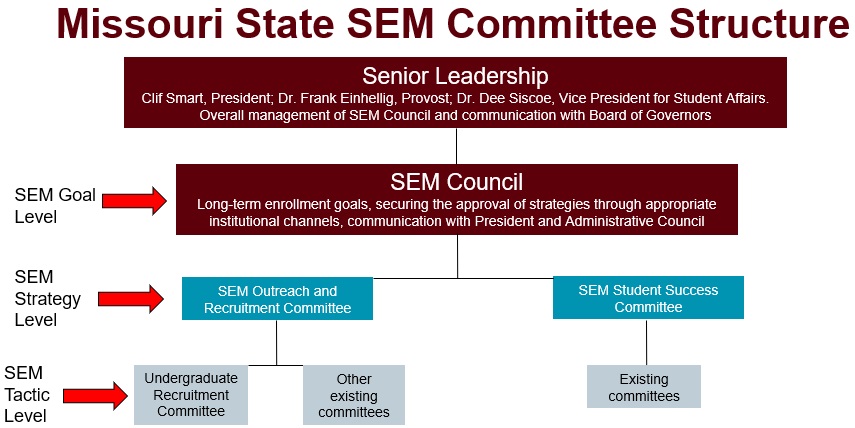The strategic enrollment management (SEM) plan is the guiding document that charts Missouri State’s path toward achieving its enrollment, recruitment and retention objectives. The university utilizes its SEM plan to make strategic decisions, prioritize initiatives and allocate resources related to enrollment.
About Strategic Enrollment Management
Strategic enrollment planning is more than a long-term recruitment or retention plan. It is a data-informed process that aligns an institution’s fiscal, academic, co-curricular, and enrollment resources with its changing environment to accomplish the institution’s mission and ensure the institution’s long-term enrollment success and fiscal health.
The four components of enrollment management are:
- Recruitment
- Retention
- Research
- Structure
SEM Structure

SEM Goals and Strategies
Review the full SEM Plan narrative.
The baseline for these goals will be fall 2020 for goals one and two, FY20 for goal three, and the 2019-20 academic year for goal four. While 2026 exists as the target date, because of varying internal and external circumstances (e.g., demographic shifts, the economy, university funding, challenges related to the pandemic, significant hindrances regarding international students), the SEM Steering Committee will annually review goals and adjust accordingly with approval from the Senior Leadership Team. In addition to recent factors, a historical enrollment perspective will be considered as well.
1. Outreach and Recruitment
By 2026, with particular focus on targeted student populations, increase overall headcount enrollment by 5% and increase FTE enrollment by 3%.
Strategies
- Through a data-driven approach, project targeted student populations (e.g., FTNICs, new UG transfers, graduate, international, underrepresented, adult/non-traditional, online, geographic location, academic aptitude) for growth or decline and develop appropriate communication and recruitment efforts accordingly.
- Elevate the reputation of the University’s academic programs through the pursuit of new and emerging academic offerings and delivery modes, enrichment of existing curriculum and research, and equipping of students for successful career outcomes that meet workforce and market demands.
- Enhance both internal and external communication and marketing about the University’s enrollment, recruitment, and brand to both maintain and grow an engaged and educated campus community, and appeal to prospective students and other external stakeholders.
- Increase emphasis on outreach through relationship-building and effective communication with high school counselors, teachers, community college advisors, community partner organizations, and access programs for underserved populations.
2. Retention and Student Success
By 2026, increase the first to second year undergraduate student retention rate by 3%, with a focus on improving retention by 5% for each of these sub-groups: African American, Hispanic/Latino/Latinx, first-generation and Pell eligible students; and improve persistence at other critical transition points.
Strategies
- Support initiatives that foster student success, develop and strengthen early alert communications, enhance advising approaches, coordinate comprehensive student life cycle communications, and enhance collaboration among units and faculty/student connections, keeping in mind the various characteristics of different student populations.
- Strengthen the first-year experience through enhancing faculty and student connections in first-year gateway and foundation courses, improving the effectiveness of GEP 101, and promoting opportunities that offer student engagement and support.
- Improve the support services for students who historically have been less likely to persist.
- Develop and strengthen programs that recruit and retain a diverse faculty and staff.
- Enhance faculty, staff, and student accountability in becoming more culturally conscious by building a stronger sense of belonging and engagement at Missouri State and in the general community.
3. Successful Graduation and/or Completion
By 2026, increase the number of credentials (e.g., degrees and certificates) awarded to 5,800 per year.
Strategies
- Collaborate with advising administrators and stakeholders to discuss and refine advising models, policies and practices, within both centralized and college/department offices to support students on successful pathways to credential completion.
- Support career readiness activities throughout the student life cycle through collaboration between the Career Center, academic and advising units, and other areas; the use of appropriate technology; and other relevant initiatives.
- Refine curricular options (i.e., degrees and certificates) and remove perceived barriers to help students successfully navigate their academic program and connect it with workforce, market, or graduate/professional school demands.
4. Financial Preparedness
By 2026, decrease the average loan debt of undergraduate degree recipients by 5% after inflation.
Strategies
- Proactively implement targeted interventions and realignments of institutional resources that help prevent attrition and decrease student loan debt.
- Develop and deploy a financial preparedness education program for students and family members that begins with the financial aid award letter and continues through graduation.
- Identify and implement advising practices that improve enrollment efficiency and therefore contribute to lowering student debt.
2023-2024 SEM Action Plan
The action plan is linked to the SEM goals and strategies. This plan will be updated and revised throughout the year.
*File accessible to Faculty and Staff on the MSU network.
Guiding principles
- Stabilize enrollment short term
- Grow enrollment in targeted areas
- Improve retention
- Facilitate successful degree and credential completion
- Broaden access to underserved populations
- Identify new and emerging academic programming that meets student and workforce demands
- Equip students for successful career outcomes
- Employ actions and modify processes that eliminate barriers that impair student success
- Raise the profile of the University
- Develop a culture of enrollment growth among faculty, staff, and students